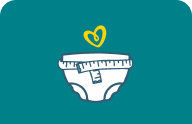What is Normal When it Comes to Baby Sleep Patterns
What is Considered a Normal Sleep Pattern by Age
If you’re a parent of a young child, you may have at some point wondered to yourself, “Is this normal?”
Whether your baby is refusing to lay down at night or waking every hour to feed, it’s helpful to know what is considered normal and when some developmentally appropriate sleep disruptions may arise. Here we break down what is considered normal for a baby’s sleep patterns by age.
Regardless of your baby’s age, it’s important to practice safe sleep practices. This includes placing your newborn or infant on their back to sleep for the first year of their life, room sharing for the first 6 months, and setting their room at the right temperature. Their crib or bassinet should have a firm mattress free of soft bedding, toys, or loose blankets.
Remember: all babies are different, and their sleep needs and patterns are no different. If you’re looking for support with instilling healthy sleep habits in your baby or think your baby may benefit from more formal sleep training, download the Smart Sleep Coach by Pampers™ app.
If you’re concerned about your baby’s sleep patterns, speak to your pediatrician.
Birth to 6-8 weeks
It's normal newborn sleep patterns may include frequent wakings to eat and short sleep cycles. On average, they sleep for 14 to 17 hours a day, divided into segments lasting anywhere from two to four hours––even though some wake windows can be even shorter. It's normal for newborns to take short 20-minute naps or longer 90-minute naps.
During the first 6-8 weeks, it’s common for newborn sleep to seem disorganized. This is because of your newborn’s immature circadian rhythms, making it hard for them to differentiate between day and night.
Despite the challenges, enjoy this phase! Savor every snuggle and newborn noise. Don't stress about schedules or worry about spoiling your newborn. This period is about bonding and understanding each other. Your newborn isn't ready to be scheduled, so focus on getting as much rest as possible.
2-4 months
Between 8 and 16 weeks old, your baby will start reaching their first significant sleep milestones. Typically, around 3- to 4-months-old, sleep will become more organized, with at least one longer stretch of sleep lasting 4-6 hours. While your baby will still need to eat during the night, it’s normal for the time they sleep between feedings to get longer.
When it comes to trying to get your baby to sleep longer stretches at night, don’t keep them awake for longer during the day––this will make it even harder for them to sleep at night because they’ll become overtired.
Around this age it’s normal for the "Witching Hour" or “PURPLE Crying Period” to begin, which is when your baby gets fussy in the afternoon or early evening before bedtime. Often this can happen after a full day of activities––they likely are tired or hungry after a busy day! It’s normal for “Witching Hour” to peak between 3 and 5 months of age and to last as much as 5 hours at a time.
Your baby also is reaching new developmental milestones of understanding and responding to cues and patterns. This is an ideal time to start establishing healthy sleep habits such as creating a consistent bedtime routine and comfortable sleep environment.
Getting to know your baby's sleepy cues—such as eye rubbing, fussiness, zoning out, ear pulling, and head turning—will help you respond quickly so they don’t become overtired. If they do become overtired, which is normal if they go to bed past a wake window, try for an earlier bedtime––it’s the best way for them to reclaim the restorative sleep they have missed during their nap.
While the sleep schedule may still be erratic, following your baby's cues will help manage their sleep and gradually support them as they get used to falling asleep independently.
4-6 months
When your baby is between 8 weeks and 16 weeks old, it’s normal for their sleep patterns to change. They start to sleep through the night or spend even more of their 12 to 16 sleeping hours at night––many babies can sleep up to 8 hours at a time, even though closer to 4 hour stretches at night is also normal.
It’s common for an infant to still wake to eat during the night. However, some may stop feeding at night at this age as they start to eat more during the day.
Naps at 4-months-old can happen 3-4 times a day, but length at this age can change dependent on your baby. Since your baby can notice patterns, they may be in a more predictable routine during the day.
If you’re trying to figure out if your baby’s sleep schedule is developmentally appropriate, take this FREE sleep quiz and get answers (and a custom sleep plan for your baby) in minutes.
6-9 months
Around 24 to 36 weeks your baby’s sleep patterns become even more refined. Their total daytime sleep is around 12 to 14 hours, and many sleep through the night, as much as 10 to 12 hours at night with 2 to 3 daytime naps.
At 6 to 9 months of age it’s normal for your baby’s nap schedule to become more predictable, and it’s normal to transition from 3 to 2 naps as well. If your baby is still feeding at night, don’t worry––it’s normal for some babies to continue to feed at night. Speak with your pediatrician about whether it’s normal or recommended for your baby to keep eating at night.
Around this time, it’s normal for your baby to experience a temporary sleep regression because of them reaching major developmental milestones. Try and remain consistent with their bedtime routines and don’t introduce bad sleep habits to keep their sleep patterns on track during times of regression.
If your baby’s sleep cycles seem off, or they are struggling with sleep and seem overtired, try for an earlier bedtime to help them recoup any lost sleep. Since the most restorative type of sleep NREM sleep happens earlier in the night, an earlier bedtime is a normal way to help them get back on track if their sleep patterns become out of whack.
9-12 months
As they approach their birthday babies’ sleep patterns become even more predictable. 10–12-hour sleep stretches at night are normal, with around 2 naps happening during the morning and afternoon. Since babies at this age often eat more solid foods during the day, night feedings at this age are often not needed (but speak to your pediatrician for personalized guidance).
At this age any change to their daytime or night routine could affect how they sleep at night. For example, an extra-long afternoon nap could mean their bedtime should be pushed to a little layer. On the flip side, if they skip a nap try pushing bedtime up to help them catch up on sleep, realign their sleep patterns, and avoid overtiredness.
After 12 months
A toddler will continue to have changes to their sleep patterns––especially during the day.
Soon after your toddler’s first birthday by 18-months-old, they likely will transition to 1 afternoon nap every day lasting around 1-2 hours. They continue to sleep a 10-12 hour stretch at night, though occasionally sleep disruptions because of milestones such as teething are normal.
Bedtime routines that include a lullaby or story are increasingly helpful for your child to wind down when it’s time for bed and keep to their normal sleep patterns.
The Bottom Line
Every baby’s sleep journey is unique. What is considered normal for your baby’s sleep patterns may be different for another's.
Your baby’s sleep needs and patterns will change, and knowing what to expect can make the whole journey of baby sleep more manageable. Smart Sleep Coach was built to keep parents abreast of what to expect in real-time and prepare you for how to support your baby’s sleep as they grow.
How We Wrote This Article The information in this article is based on the expert advice found in trusted medical and government sources, such as the American Academy of Pediatrics and the American College of Obstetricians and Gynecologists. You can find a full list of sources used for this article below. The content on this page should not replace professional medical advice. Always consult medical professionals for full diagnosis and treatment.








